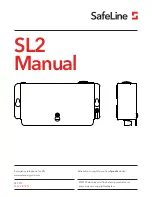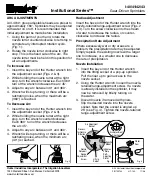
2 — INSTALLATION SPECIFICATIONS AND WIRING
Curtis Model 1351 – December 2018
pg. 22
Pot Inputs
The 1351 System Controller provides Analog Inputs 9 and 10 to be configured for connection to a
potentiometer. Potentiometers can be connected as 2-wire using only the wiper (Analog 9/pin 20)
and ground (I/O Gnd, pin 8), or 3-wire, using the wiper, ground, and Analog 10 (pin 21) for pot
high. The potentiometer input can be configured for a throttle, brake, steer, or other uses. The wiring
diagram (
) illustrates this usage as a 3-wire lift/lower configuration.
When the analog inputs are configured for use with a potentiometer, the signals are dynamically
tested, increasing the fault detection of the potentiometer and wiring beyond just basic out-of-range
detection. The total resistance and the wiper position are constantly measured and calculated.
Table 10 Potentiometer Input Electrical Specifications
Signal Name
Pin
Pot Resistance
Range / Tolerance
Available Current
Input
Impedance
Output
Voltage
Fault
Detection
Pot Hi
21
3-wire: 0 – 15 kΩ / 0 – 2k Ω
3 mA supplied, max.
> 178 kΩ
15 V
(nominal)
Shorted to:
B+
B–
I/O Gnd
Open
Wiper
20
2/3-wire: 0 – 15 kΩ / 0 – 2k Ω
3 mA supplied, max.
Shorted to:
B+
B–
I/O Gnd
Pot Hi
Open
I/O GND
8
—
—
—
Open
RTD Inputs
The resistive temperature device (RTD) inputs, RTD Inputs 1 – 4, are connected to Analog Inputs
5 – 8 respectively. Specific or selectable RTD devices are not offered—rather each RTD input is
configured (mapped) according to its resistive characteristics. This means the 1351’s RTD Inputs can
accommodate resistive devices for temperature, position, pressure, etc., solely based upon the resistive
sensor and/or a given range determined by the user. For example, a 3-wire “steer angle” potentiometer
is illustrated in the example wiring diagram (
) for RTD 4 input, with RTDs utilized for the
oil temperature, oil pressure, and engine temperature connected to RTD inputs 1, 2, and 3.
The RTD parameter-mapping feature can be used for linearizing temperature diodes or NTC resistors
to provide values in Fahrenheit or Celsius. Another example is when a potentiometer is used to
measure drive wheel angle by a cam or level arm, which provide a non-linear movement based on
angle. This happens on 4-wheel trucks with Ackerman steering geometry and/or dual drive vehicles.
The steered angle can also be picked up off the actual hydraulic ram using the RTD mapping feature.
Alternatively, use the RTD to convert a tiller steering arm to have more sensitivity near center and
then greater angle gain when close to the limits.
















































